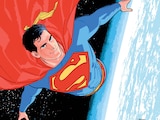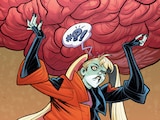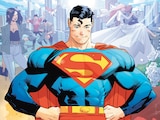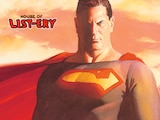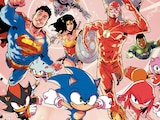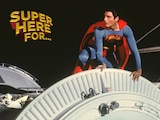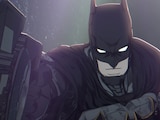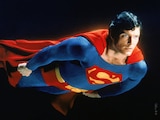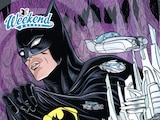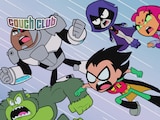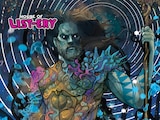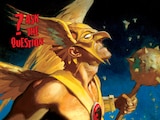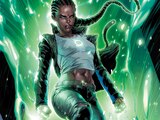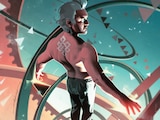As we celebrate Women’s History Month, it’s the perfect time to spotlight some pivotal moments that helped shape the DC Universe. For example, do you know who DC’s first female character was? Did you know DC’s first female superhero was a mother and grocer? Did you know that if it wasn’t for its female editors and executives, the company wouldn’t be called DC, and we never would’ve gotten Vertigo? Let’s explore seven milestones in DC’s history that were shaped by women.

1935: Sandra of the Secret Service, DC’s First Female Character
Years before Wonder Woman first swung her Lasso of Truth, Sandra McClane was battling dictators and outsmarting mad scientists. Sandra first appeared in 1935’s New Fun Comics #1, the first comic book ever published by National Publications (later renamed DC). “Sandra of the Secret Service” was the second feature in the story, immediately following Jack Wood’s cover feature. This means that Sandra Woods is not only the first female to headline a DC story, but she was the first female character to appear in a DC story PERIOD.
While other female characters were getting captured or swooning over the male heroes, Sandra was an action hero, and at times she would be the one to save her male colleagues. Sandra hasn’t been seen since More Fun Comics #35, which ended in a cliffhanger where the villain gets away. Perhaps one day we’ll see how it ends. In the meantime, we can celebrate Sandra for the doors she broke down, ushering in other female characters like Wonder Woman, Lois Lane, Batgirl, Zatanna and more.

1935: Emma C. McKean, DC’s First Female Creator
New Comics (not to be confused with New Fun Comics) was another series released by National Publications in 1935. When a cartoonist named Emma C. McKean contributed activity pages and comic strips to the first issue, she became DC’s first female creator. Some comic historians have gone further, theorizing that McKean might be the first female to contribute to a comic EVER. What we do know for certain is that using the pen name Ema Kean, McKean wrote and illustrated a few comic strips for New Comics, including Sister and Brother. The stories were humorous in nature, often focusing on the innocence of youth.
(For a comprehensive list of DC’s early female writers, check out this recent Women’s History Month article by Alex Jaffe.)

1940: Red Tornado, DC’s First Female Superhero
DC’s first female superhero wasn’t an Amazonian goddess or an alien princess. She was just a normal mother who wanted to protect her children. While most of you may know the Red Tornado as an android who fights alongside the Justice League, the original version of the character was a grocer with a homemade costume.
Abigail “Ma” Hunkel was originally a supporting character in the All-American Comics feature “Scribbly the Boy Cartoonist.” Ma was the mother of Huey Hunkel, a friend of the title character, Scribbly Jibbet. “Scribbly the Boy Cartoonist” was largely a humor feature, and when superheroes became popular, the comic came up with an interesting way to parody the craze. When Ma Hunkel’s kids were kidnapped, she put together her own homemade costume to save the children. Donning a pair of long johns, and using a cooking pot as a helmet, Ma Hunkel sprang into action as the Red Tornado. After saving her kids, the Red Tornado stuck around, eventually taking over Scribbly’s feature. Ma even earned herself a spot at the Justice Society’s first meeting in All-Star Comics #3.
Due to Ma’s large stature and unusual strength, most of Red Tornado’s foes assumed the hero was a man. For her part, Ma was in no rush to correct them. Today Ma’s superhero legacy continues, thanks to her granddaughter Maxine Hunkel aka Cyclone.
(NOTE: There is some debate on who DC’s first female superhero is. Adventurers like Sandra McClane and Miss X predate Red Tornado, but neither of them could be considered a costumed hero. Wonder Woman is DC’s first super-powered female hero, but she debuted after Red Tornado. Some would argue that Red Tornado isn’t a true superhero because she doesn’t have powers, but by that standard, Batman or Green Arrow wouldn’t be superheroes either. Besides, it’s Women’s History Month, let’s not be stingy! I’m calling Red Tornado a superhero, but our girl Diana would set her own milestone just two years later...)

1942: Wonder Woman Becomes the First Woman to Headline Her Own DC Comic
We can’t talk about the history of women in DC Comics without talking about Wonder Woman. The Amazonian warrior (who debuted in 1941’s All-Star Comics #8) is one of the most recognizable superheroes in the world, cementing her place in popular culture. In 1942, Diana did something no other woman in the DC Universe had ever done—star in her own comic book. After a successful run of stories in Sensation Comics, it was clear that readers wanted more Wonder Woman.
1942’s Wonder Woman #1 was the first DC Comic to feature a female as the title character. This becomes even more impressive when you put it in the context of the time period. During the early 1940s, most comic books were anthologies featuring multiple characters and features. It was rare for an ongoing comic to be devoted to a single character, unless they were as huge as Batman or Superman. That’s a testament to Wonder Woman’s popularity. Today, DC’s publishing line is filled with numerous female-led titles, and it all started here.

1975: Cathy Lee Crosby and Lynda Carter Become the First Actresses to Lead a Live Action DC Project
Is it any surprise that Wonder Woman is on this list twice? It shouldn’t be, especially when you consider the legacy of Lynda Carter’s performance as Diana.
In 1975, ABC and Warner Bros. Television teamed up to produce Wonder Woman, a live-action television adaptation of the DC Comics heroine. The project began as a 1974 TV film starring Cathy Lee Crosby. This lesser-known film bore little resemblance to the comics, lacking the iconic costume and powers. Crosby’s Wonder Woman was more of a secret agent than she was an Amazon. Nevertheless, her performance as the title character was wonderful in its own way and groundbreaking, considering the lack of live action female superheroes at the time.
Wonder Woman was retooled as an ongoing show in 1975, this time with Lynda Carter in the title role. These days, the show is probably best remembered for its iconic theme song, campy action scenes and Diana’s now-iconic spin. And of course, for Carter herself. The actress embodied everything about Wonder Woman, from her strength to her compassion.
There have been numerous DC television and film projects over the years, but Wonder Woman marks the first time a woman was the title character for one of them. Like Wonder Woman herself, Crosby and Carter broke barriers, setting the stage for DC leading ladies like Helen Slater, Gal Gadot, Margot Robbie and Melissa Benoist.

1981: Jenette Kahn Becomes President of DC Comics
Whether you realize it or not, many of the things we love about DC came from Jenette Kahn. In 1976, Kahn (a former children’s magazine publisher) was named publisher of DC Comics—and one of her first acts was officially naming the company “DC Comics.” Prior to that, the company was known as National Publications, even though everyone had unofficially been referring to the publisher as DC. Kahn also commissioned a graphic designer named Milton Glaser to design the iconic bullet logo that branded DC books throughout the 1980s.
As publisher, Kahn was one of DC’s biggest defenders. Kahn convinced Warner Publishing that comics were still a worthwhile venture at a time when sales were dropping. Just think, if it wasn’t for Kahn, we might not have DC today, and if we did, it might not be called DC!
In 1981, Kahn was promoted to president of DC Comics. This made her the first woman to lead a division of Warner Bros. Under Kahn’s leadership, DC’s creators were encouraged to try new things. This resulted in some of the company’s biggest hits, including Watchmen and The Dark Knight Returns. Kahn proved that the publisher could tell adult oriented stories, remaking not only DC, but the comics medium as a whole.

1993: Karen Berger Launches Vertigo
In 1993, DC editor Karen Berger was the given the opportunity to launch her own imprint, resulting in the birth of Vertigo. Prior to then, Berger had edited some of DC’s most revolutionary titles, including Alan Moore’s Swamp Thing and Grant Morrison’s Doom Patrol. Berger had also helped launch Neil Gaiman’s The Sandman, a series that marveled critics and became one of DC’s most beloved titles.
Vertigo built on the success of these titles, producing a new wave of experimental titles by talented creators. Under Berger’s leadership, Vertigo published books like V for Vendetta, Y: The Last Man, Fables and many more. Berger took many risks with Vertigo, and many of those gambles paid off bigtime, resulting in some of the industry’s most thought-provoking, boundary-pushing comics to date.
And this is just the 20th century! Powerful women continue to shape the DC Universe today. What’s next for DC? Only time will tell, but one thing is certain—the future is female!
Joshua Lapin-Bertone writes about TV, movies and comics for DC.com, is a regular contributor to the Couch Club and writes our monthly Batman column, "Gotham Gazette." Follow him on Twitter at @TBUJosh.
NOTE: The views and opinions expressed in this feature are solely those of Joshua Lapin-Bertone and do not necessarily reflect those of DC or Warner Bros. Discovery, nor should they be read as confirmation or denial of future DC plans.

